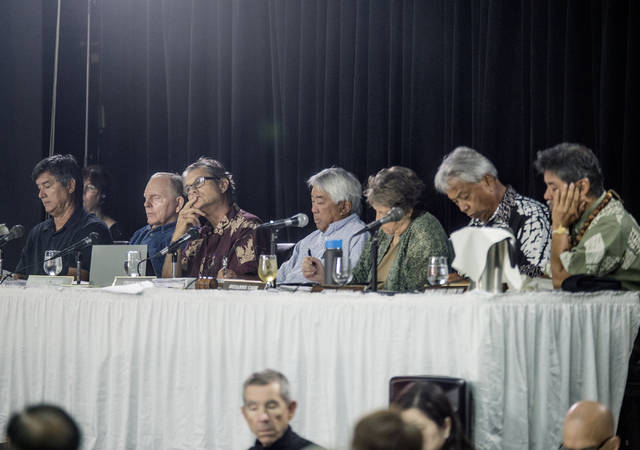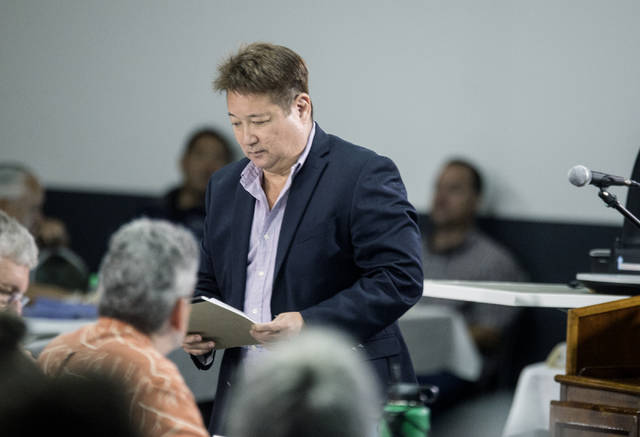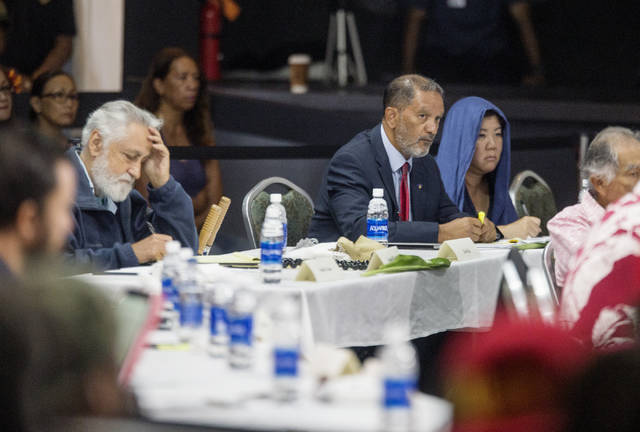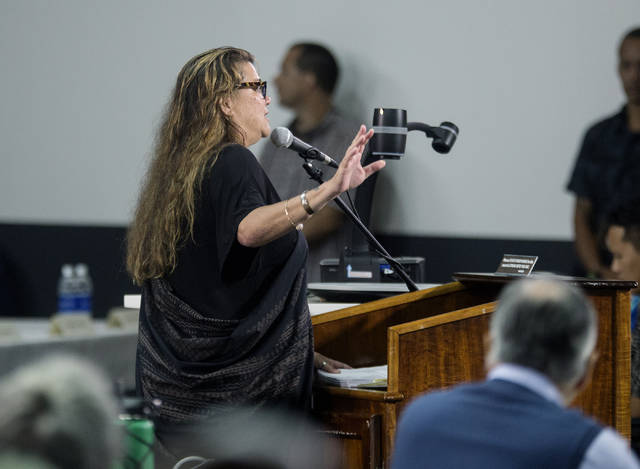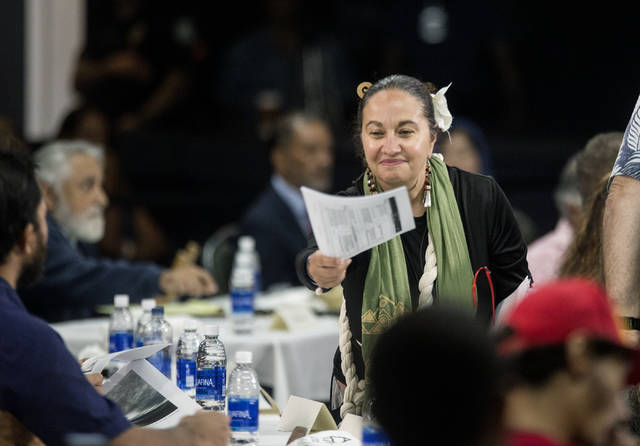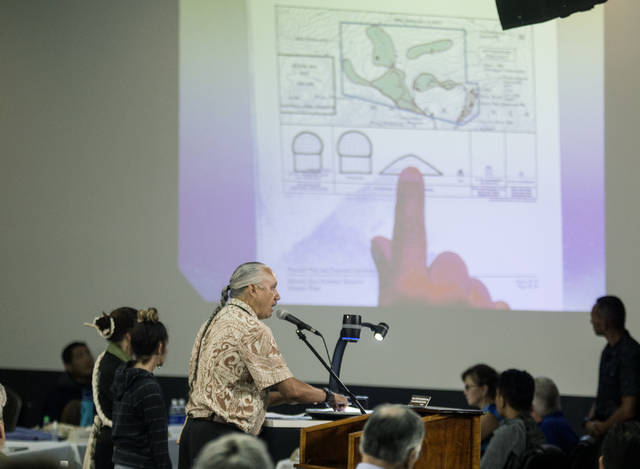The Thirty Meter Telescope is again in the hands of the state Board of Land and Natural Resources.
After a full day of testimony, and time to ask its own questions of supporters and opponents, the seven-member panel ended a hearing Wednesday in Hilo without making a decision regarding whether the next-generation telescope should be built on Mauna Kea, leaving that for an undetermined date.
“We appreciate the energy you put into this,” board member Stanley Roehrig of Keaukaha told those present before the conclusion of the meeting, attended by nearly 200 people. “It’s a very difficult process for all of us.”
The hearing capped a monthslong contested case and allowed the two dozen participants to make their arguments for or against a hearing officer’s recommendation that a new land use permit be granted for the $1.4 billion project, opposed by some Native Hawaiians who say it will desecrate sacred ground.
Hearing officer Riki May Amano, a retired judge, issued her proposed order in July after 44 days of testimony, concluding the telescope complies with criteria for building in a resource subzone of a Conservation District.
On Wednesday, conch shells and applause punctuated testimony of the project’s opponents, who said the mountain already is overdeveloped and asserted the project would infringe on cultural practices.
“Mauna Kea is sacred and that is undisputed,” said Kalani Flores. “… We are at a point where we know this mountain is significant, not just on a cultural perspective, but an environmental perspective. The question is: How much more do you impose on this mountain?”
The hearing represented a full circle for TMT. The project received a permit from the board in 2013 following an earlier contested case, only to see it taken away nearly two years ago when the state Supreme Court overturned the board’s decision because of a procedural violation.
The high court found the board erred by initially voting in support pending the outcome of the first contested case, a decision the judges found violated the due process rights of the opponents. Protests that resulted in arrests also halted construction in 2015.
The TMT International Observatory board set April 2018 as a deadline for resuming construction, and is considering the Canary Islands as an alternative site to Hawaii.
“Everyone had the opportunity to be heard as part of the process, and we are hopeful that the board will act quickly on its decision and that it will be a positive one for TMT,” said TIO Executive Director Ed Stone in a statement. “We thank all of our supporters and friends who have been with us during the hearing process over the past 10 years.”
During the hearing, opponents said the board needs to put land stewardship and native rights ahead of the project’s interests.
“Make no mistake there is an injury and there is a continued injury and there will be another injury if TMT is built,” said Kealoha Pisciotta.
Several expressed skepticism of the process, while some argued the TMT can’t be built on the mountain because it remains part of the Hawaiian kingdom.
Douglas Ing, attorney for TIO, said opponents did not demonstrate during the contested case that TMT would stop them from praying on the mountain or that protected practices occur in the project area below the summit.
“They believe they have veto power,” he said, regarding the cited religious beliefs. “The law does not support that.”
Ing said TIO is breaking from past models by investing $1 million a year in educational programs in the state and agreeing to lease payments that would top $1 million after 11 years.
“Astronomers are people, too,” he said during his rebuttal. “They, too, follow the winds of their souls. They are protectors, they protect the quest for knowledge. … And they search for the origins of life. So let us continue this pursuit.”
Several TMT opponents who helped block construction vehicles in 2015 said they would not allow construction to resume, no matter the outcome.
“I’m here today because I will die for that mountain,” said Mehana Kihoi. “I will die for aloha aina, I will die knowing my daughter would rise up and take my place.”
She later told a reporter that a ban on violence known as “kapu aloha” would remain in effect. “Sacred mountain, sacred conduct,” Kihoi said.
Several opponents asked for a stay on construction, assuming the permit is approved, to allow for an appeal.
TIO lost its sublease last December after Judge Greg Nakamura ruled the board should have granted Flores a contested case for that decision. The state appealed that decision to the state Supreme Court.
Attorney Dexter Kaiama, representing environmental group KAHEA, asked two board members to recuse themselves: Roehrig and Samuel Gon.
He said Roehrig has conflicts of interest because he leases a home in Keaukaha to a nonprofit led by Keahi Warfield, president of Perpetuating Unique Educational Opportunities Inc., a pro-TMT group that’s part of the contested case.
Gon was on the board when it voted on the issue before, Kaiama said.
During the hearing, Roehrig blasted the University of Hawaii, the permit applicant and leaseholder of the Mauna Kea Science Reserve, for not responding to PUEO’s proposed conditions regarding a cultural center on the mountain and additional educational programs for Hawaiians.
“You know this is a critical issue,” he said. “I’m greatly disturbed.”
Roehrig also criticized the university for removing ahu, or stone altars, from the mountain if they are not considered historic.
In a statement, UH spokesman Dan Meisenzahl said the university is confident that it met the eight criteria for building in a Conservation District.
“The university will continue to build on the great work by the Mauanakea Management Board, Office of Maunakea Management and Kahu Kū Mauna over the last 17 years,” he said. “We know there is a lot of work to do and as the Board of Regents affirmed in a resolution adopted in August, we are committed to collaborative stewardship with all stakeholders of Maunakea’s cultural, natural, educational and scientific resources.”
The telescope organization’s partners are Caltech, University of California, Association of Canadian Universities for Research in Astronomy and national institutes in Japan, China and India.
Email Tom Callis at tcallis@hawaiitribune-herald.com.







